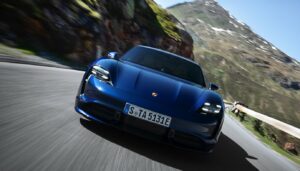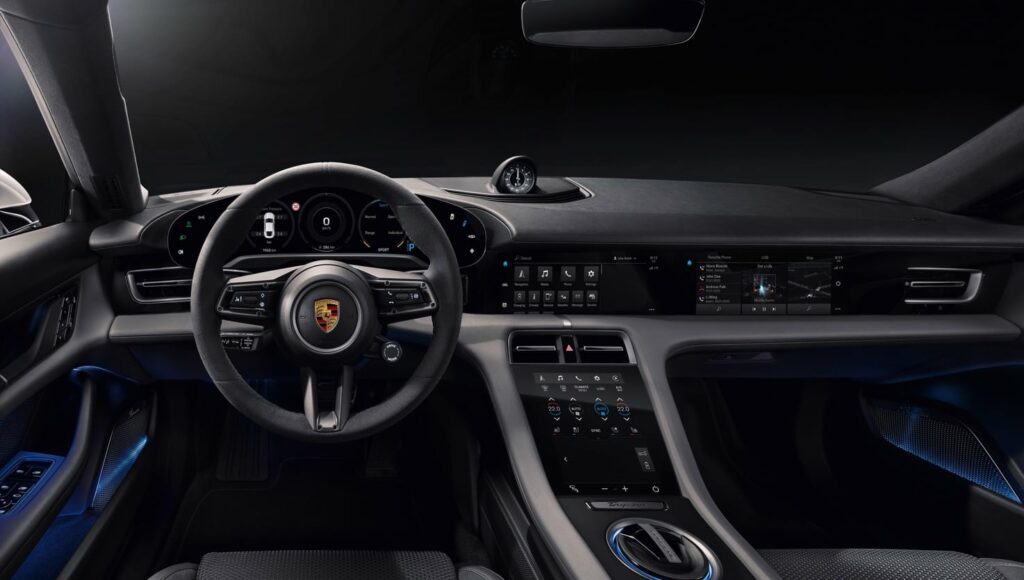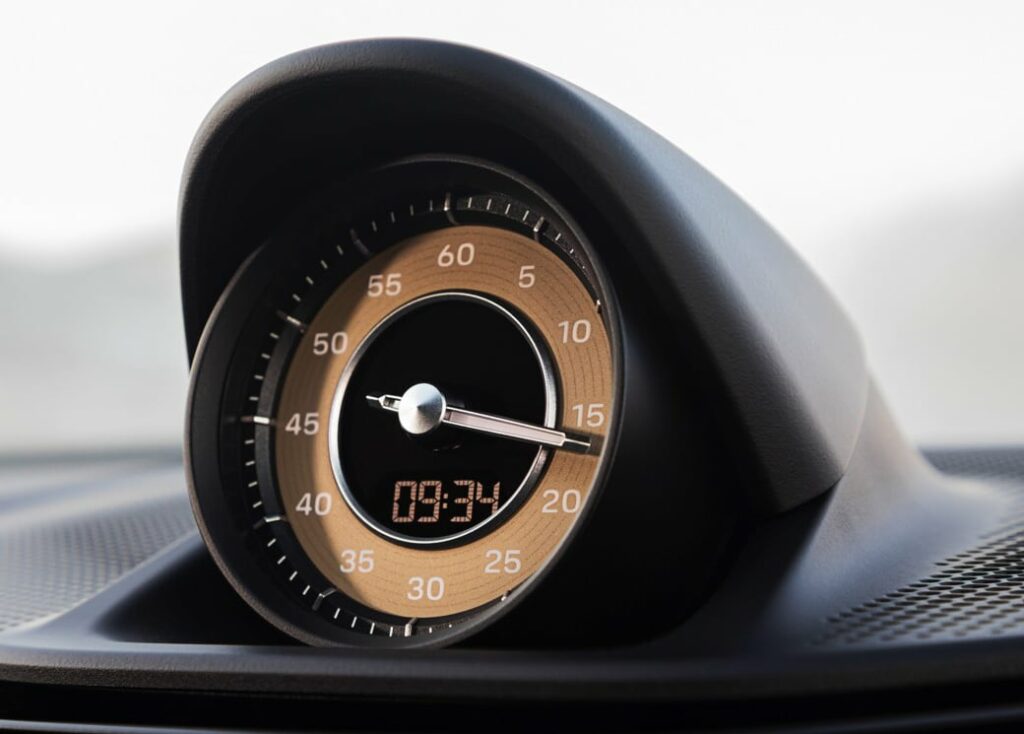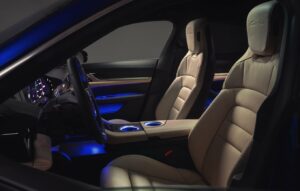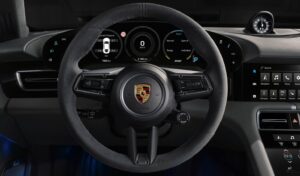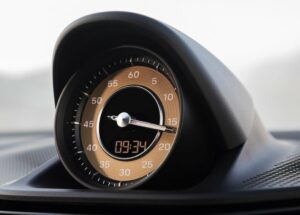Porsche Taycan
The Porsche Taycan is an all-electric sports car produced by the German automaker Porsche. It was first introduced as a concept car in 2015, and the production version was introduced in September 2019. The Taycan is Porsche’s first all-electric car and is available in several different versions, including the Taycan 4S, Taycan Turbo, and Taycan Turbo S.

The Taycan is built on a new electric platform developed by Porsche called the J1 platform, which is also shared with the Audi e-tron GT. The car is powered by two electric motors, one in the front and one in the rear, which together produces up to 300 kW in the top-end Turbo S model. The car accelerates from 0 to 60 mph in just 5.4 seconds and reaches a top speed of 230 km/h.

The Taycan’s battery capacity ranges from 79.2 kWh to 93.4 kWh, depending on the model. The car can be charged on a DC fast charger with up to 270 kWh, which provides an 80% charge in just 22.5 minutes. The car’s range depends on the model and battery size, with the most powerful model (Taycan 4S with a 93.4 kWh battery) capable of driving up to 395 km on a single charge, according to EPA estimates.
Overall, the Porsche Taycan represents a significant step forward for electric vehicles, offering impressive performance and range, and showcasing Porsche’s design and engineering expertise.
| Performance | |
| Acceleration 0 – 100 km/h | 5.4 sec |
| Top Speed | 230 km/h |
| Electric Range | 395 km |
| Total Power | 300 kW (408 PS) |
| Total Torque | 345 Nm |
| Drive | Rear |
| Battery and Charging | |
| Battery Capacity | 79.2 kWh |
| Battery Useable | 71.0 kWh |
| Europe | |
| Charge Port | Type 2 |
| Port Location | Right Side – Front |
| Port Location 2 | Left Side – Front |
| Charge Power | 11 kW AC |
| Charge Time (0->395 km) | 7h45m |
| Charge Speed | 52 km/h |
| Fastcharge Port | CCS |
| FC Port Location | Right Side – Front |
| FC Port Location 2 | – |
| Fastcharge Power (max) | 225 kW DC |
| Fastcharge Time (40->316 km) | 21 min |
| Fastcharge Speed | 790 km/h |
| Energy Consumption | |
| EVDB Real Range | |
| Range | 395 km |
| Vehicle Consumption | 180 Wh/km |
| CO2 Emissions | 0 g/km |
| Vehicle Fuel Equivalent | 2.0 l/100km |
| WLTP Ratings (TEL) | |
| Range | 431 km |
| Rated Consumption | 204 Wh/km |
| Vehicle Consumption | 165 Wh/km |
| CO2 Emissions | 0 g/km |
| Rated Fuel Equivalent | 2.3 l/100km |
| Vehicle Fuel Equivalent | 1.9 l/100km |
| WLTP Ratings (TEH) | |
| Range | 354 km |
| Rated Consumption | 248 Wh/km |
| Vehicle Consumption | 201 Wh/km |
| CO2 Emissions | 0 g/km |
| Rated Fuel Equivalent | 2.8 l/100km |
| Vehicle Fuel Equivalent | 2.3 l/100km |
| TEL = Test Energy Low | TEH = Test Energy High | |
|
Rated = official figures as published by manufacturer. Rated consumption and fuel equivalency figures include charging losses.
|
|
|
Vehicle = calculated battery energy consumption used by the vehicle for propulsion and on-board systems.
|
|
| Real Energy Consumption between 127 – 245 Wh/km | |
| City – Cold Weather | 189 Wh/km |
| Highway – Cold Weather | 245 Wh/km |
| Combined – Cold Weather | 215 Wh/km |
| City – Mild Weather | 127 Wh/km |
| Highway – Mild Weather | 192 Wh/km |
| Combined – Mild Weather | 156 Wh/km |
| Energy use for each trip will vary considerably depending on the driver and the conditions. Therefore, we have provided a range of estimates which can be useful in developing an understanding of the potential benefits of this technology. | |
| Safety (Euro NCAP) | |
| Adult Occupant | 85% |
| Child Occupant | 83% |
| Rating Year | 2019 |
| Vulnerable Road Users | 70% |
| Safety Assist | 73% |
| Dimensions and Weight | |
| Length | 4963 mm |
| Width | 1966 mm |
| Width with mirrors | 2144 mm |
| Height | 1395 mm |
| Wheelbase | 2900 mm |
| Weight Unladen (EU) | 2125 kg |
| Gross Vehicle Weight (GVWR) | 2795 kg |
| Max. Payload | 745 kg |
| Cargo Volume | 407 L |
| Cargo Volume Max | No Data |
| Cargo Volume Frunk | 84 L |
| Roof Load | 75 kg |
| Tow Hitch Possible | No |
| Towing Weight Unbraked | 0 kg |
| Towing Weight Braked | 0 kg |
| Vertical Load Max | 0 kg |
| Miscellaneous | |
| Seats | 4 people |
| Isofix | Yes, 2 seats |
| Turning Circle | 11.7 m |
| Platform | VW J1 |
| Car Body | Sedan |
| Segment | F – Luxury |
| Roof Rails | No |
| EV Dedicated Platform | Yes |
Home and Destination Charging (0 -> 100%)
A public charging station is required to use the highest possible charging rate. The EVSE/charging station’s charging capacity affects how long it takes to fully charge the battery. The table below shows all possible options for fully charging the Porsche Taycan.
In Europe, plugging an electric car into an outlet is often as easy as plugging it into a household outlet, but there are differences from country to country. The table below shows the different ways to charge the Porsche Taycan, but in some countries some chargers may not be available.
Type 2 ( IEC 62196)

| Charging Point | Max. Power | Power | Time | Rate |
| Standard 11.0 kW On-Board Charger | ||||
| Wall Plug (2.3 kW) | 230V / 1x10A | 2.3 kW | 36h30m | 11 km/h |
| 1-phase 16A (3.7 kW) | 230V / 1x16A | 3.7 kW | 22h45m | 17 km/h |
| 1-phase 32A (7.4 kW) | 230V / 1x32A | 7.4 kW | 11h30m | 34 km/h |
| 3-phase 16A (11 kW) | 400V / 3x16A | 11 kW | 7h45m | 51 km/h |
| 3-phase 32A (22 kW) | 400V / 3x16A | 11 kW | 7h45m | 51 km/h |
| Optional 22.0kW On-Board Charger | ||||
| Wall Plug (2.3 kW) | 230V / 1x10A | 2.3 kW | 36h30m | 11 km/h |
| 1-phase 16A (3.7 kW) | 230V / 1x16A | 3.7 kW | 22h45m | 17 km/h |
| 1-phase 32A (7.4 kW) | 230V / 1x32A | 7.4 kW | 11h30m | 34 km/h |
| 3-phase 16A (11 kW) | 400V / 3x16A | 11 kW | 7h45m | 51 km/h |
| 3-phase 32A (22 kW) | 400V / 3x32A | 22 kW | 4 hours | 99 km/h |
Fast Charging (10 -> 80%)
If you want to enjoy driving an electric car, one of the most important features to consider is the number of miles per hour the car can travel while charged. This is called the “range” of the car. All electric cars have a certain range, even if they are 100% charged. This is because they do not have an internal combustion engine to lean on if you need to drive a long distance.
Max. Power: The maximum power provided by the charging point
Avg. Power: The average power provided by the charging point during a session of 10% to 80%.
Time: the time it takes to charge from 10% to 80%
Speed: the average charging rate during the session of 10% to 80%
Combined Charging System (CCS Combo 2)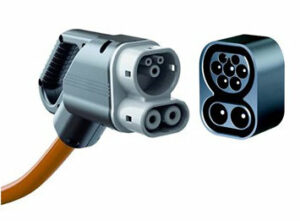
| Charging Point | Max. Power | Avg. Power | Time | Rate |
| CCS (50 kW DC) | 50 kW | 50 kW | 63 min | 260 km/h |
| CCS (100 kW DC) | 100 kW | 90 kW | 35 min | 470 km/h |
| CCS (150 kW DC) | 150 kW | 115 kW | 27 min | 610 km/h |
| CCS (175 kW DC) | 175 kW | 125 kW | 25 min | 660 km/h |
| CCS (350 kW DC) | 225 kW | 150 kW | 21 min | 790 km/h |
| Brand | Porsche |
| Model | Taycan |
| Body Style | Sedan |
| Car Engine | electric |
| Motor power | 300 |
| Maximum Torque, Nm | 345 |
| Battery Energy, kWh | 79.2 |
| Power reserve (NEDC/EPA/WLTP), km | - / - / 395 |
| Level Charging (230/400/DC), hours | - / 4.0 / 0.21 |
| Electrical Acceleration, 0-100 km/h (0-62.1 mph) in sec | 5.4 |
| Top Speed, km/h | 230 |

















